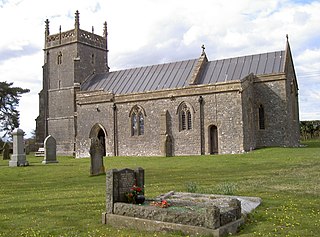
Wells is a cathedral city and civil parish in the Mendip district of Somerset, located on the southern edge of the Mendip Hills, 21 miles (34 km) south-east of Weston-super-Mare, 22 mi (35 km) south-west of Bath and 23 mi (37 km) south of Bristol. Although the population recorded in the 2011 census was only 10,536, and with a built-up area of just 3.244 square kilometres, Wells has had city status since medieval times, because of the presence of Wells Cathedral. Often described as England's smallest city, it is actually second smallest to the City of London in area and population, but unlike London it is not part of a larger urban agglomeration.

Westbury-sub-Mendip is a village in Somerset, England, on the southern slopes of the Mendip Hills 4 miles (6.4 km) from Wells and Cheddar.

Rodney Stoke is a small village and civil parish, located at grid reference ST486501, 5 miles north-west of Wells, in the English county of Somerset. The village is on the A371 between Draycott and Westbury-sub-Mendip.

The Grade I listed buildings in Somerset, England, demonstrate the history and diversity of its architecture. The ceremonial county of Somerset consists of a non-metropolitan county, administered by Somerset County Council, which is divided into five districts, and two unitary authorities. The districts of Somerset are West Somerset, South Somerset, Taunton Deane, Mendip and Sedgemoor. The two administratively independent unitary authorities, which were established on 1 April 1996 following the breakup of the county of Avon, are North Somerset and Bath and North East Somerset. These unitary authorities include areas that were once part of Somerset before the creation of Avon in 1974.

The Church of St Peter and St Paul dominates the village of Bleadon, Somerset, England.

The Church of St Mary in Berrow, Somerset, England dates from the 13th century and was restored in the 19th. It has been designated as a grade I listed building.

The Church of St Dunstan in Baltonsborough, Somerset, England, was built in the 15th century. It has been designated as a Grade I listed building.

The Church of St Mary Magdalene in Great Elm, Somerset, England, dates from the 12th century and is a Grade I listed building.

St. Mary's Hemington is an Anglican church in Hemington, Somerset, England. The Norman church underwent major renovation in the 14th, 15th, 17th and 19th centuries. The south aisle and nave are the oldest part dating from the 1340s. The tower, was built between 1480 and 1500. The 19th century work is attributed to the office of Sir George Gilbert Scott.

The Anglican Church of St Peter and St Paul in Kilmersdon, Somerset, England, dates back to the Norman period, though much of the current structure was built during the 15th and 16th centuries and restored in the Victorian era. It is a Grade I listed building.

The Church of St Giles in Leigh-on-Mendip, Somerset, England, dates from around 1350, and was rebuilt around 1500. It is a Grade 1 listed building, with an unusual faceless clock.

The Church of All Saints is a Church of England parish church in Lullington, Somerset, England.

The Church of St Mary in Meare, Somerset, England, was formerly in the keeping of Glastonbury Abbey, and dates from 1323. It was built for Abbot Adam of Sodbury, and is a Grade I listed building.

The Church of St John the Baptist in Pilton, Somerset, England, dates from the 11th century and has been designated as a Grade I listed building.

The Anglican Church of St Lawrence at Priddy, Somerset, England, dates from the 13th century, with some rebuilding in the 15th century and was restored in 1881–88; it is a Grade I listed building.

The Church of St Nicholas in West Pennard, Somerset, England, dates from the 15th century and is a Grade I listed building.

The Church of St Matthew in Wookey, Somerset, England, dates from the twelfth century and is a Grade I listed building.

The Church of St Margaret in Hinton Blewett, Somerset, England probably dates from the 13th century although parts are as late as the 16th or 17th century. It has been designated as a Grade I listed building.

The Anglican Church of St Benedict at Glastonbury within the English county of Somerset was built as a Norman chapel in the 11th century with substantial additions in the 15th and 19th centuries. It is a Grade I listed building.

The Anglican Church of St Lawrence in Cucklington, Somerset, England, was built in the 13th century. It is a Grade II* listed building.





















